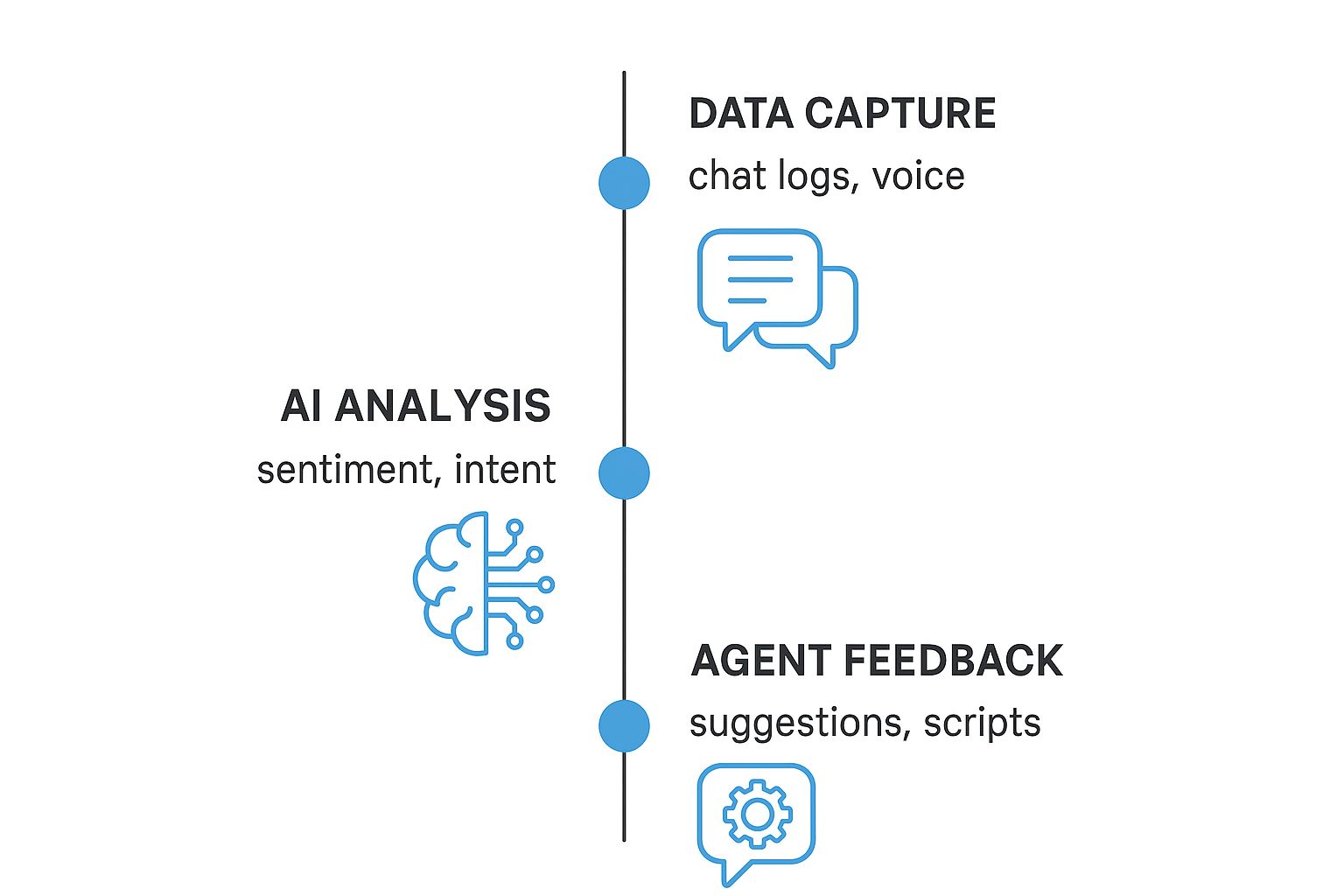June 2, 2025
Real Time Agent Assistance: Transform Support With AI Power
The Real-Time Agent Assistance Revolution Is Here
Real-time agent assistance is reshaping customer service. It's no longer a thing of the future, but a present-day reality affecting how businesses connect with their customers. This change is driven by the shortcomings of traditional support methods, often unable to meet rising customer expectations and increasingly complex questions. Leading companies are now using AI-powered assistance to address this challenge and create positive customer experiences that foster loyalty and encourage positive reviews.
This new approach to customer service focuses on giving agents the resources they need to excel. Imagine a support agent handling a complicated technical problem. Rather than placing the customer on hold to search through extensive knowledge bases, real-time agent assistance delivers relevant information instantly, directly within their existing workflow. This helps agents resolve issues faster and more effectively, leading to higher customer satisfaction.
Core Components of Effective Real-Time Agent Assistance
Real-time agent assistance involves more than simple chat tools. Advanced platforms employ several key components to achieve tangible results. These components work together to improve an agent's ability to provide efficient and personalized support:
-
Intelligent Suggestion Engines: These engines analyze customer conversations in real time and suggest relevant responses, knowledge base articles, and recommended next steps to agents. This reduces agent workload and ensures consistent, high-quality service.
-
Predictive Response Capabilities: By anticipating customer needs based on past data and current conversation context, these tools empower agents to proactively address potential problems and personalize the interaction.
-
Contextual Knowledge Base Integration: Real-time agent assistance seamlessly integrates with your company's existing knowledge base, supplying agents with the specific information they need at the right moment, without having to switch between multiple systems. You might be interested in: How to master real-time agent assistance.
Integrating Real-Time Agent Assistance Effectively
Implementing real-time agent assistance is not about replacing human agents, but about enhancing their abilities. The goal is to integrate these solutions strategically without overburdening your team. Begin with specific situations where real-time assistance can provide the greatest benefit, such as answering frequently asked questions or offering support for complex products. Gradually expand implementation as your team becomes more skilled and comfortable with the new tools.
Moreover, the market for this technology is experiencing rapid growth. The global Real-Time AI Agent Assist Market is projected to expand from USD 4.4 billion in 2024 to an impressive USD 124.6 billion by 2034, representing a CAGR of 39.70%. This rapid expansion highlights the significant potential of real-time agent assistance to transform the customer service industry. Discover more insights about this growing market. By strategically adopting this technology, businesses can achieve new levels of efficiency, increase customer satisfaction, and ultimately, drive business growth.
Industry Adoption: Who's Leading The Charge
Real-time agent assistance isn't a universal solution. Its adoption varies across industries, creating a diverse landscape of early adopters, hesitant followers, and those in between. These differences stem from unique business needs, customer expectations, and existing system complexities. For instance, industries with high customer interaction volumes and complex products, like e-commerce, often lead in adoption. They recognize the immediate value of empowering agents to handle diverse inquiries efficiently.
Sector-Specific Applications
E-commerce companies use real-time agent assistance to provide personalized product recommendations, instantly address shipping inquiries, and resolve complex technical issues. This improves customer experience and boosts sales conversions.
Similarly, healthcare providers are using real-time assistance to streamline appointment scheduling, answer insurance questions, and ensure accurate information dissemination. This critical support enhances patient care and reduces administrative burdens.
In financial services, real-time assistance plays a vital role in fraud detection, transaction processing, and personalized financial advice, ensuring security and customer satisfaction.

Regional Differences and Infrastructure Impact
Adoption patterns also have geographical variations. North America, particularly the U.S., leads the market, holding over 45.5% of the global share in 2024. The U.S. market alone reached USD 1.7 billion. This leadership is due to the region's advanced technological infrastructure and high demand for automation. Find more detailed statistics here.
Other regions are catching up quickly, driven by the increasing recognition of real-time agent assistance's ability to transform customer service and operational efficiency. The availability of skilled professionals to implement and maintain these systems also influences regional success.
The following table provides a snapshot of regional market share and growth projections:
Real Time Agent Assistance Market Growth by Region
| Region | Market Share % | Market Value (USD) | Growth Rate |
|---|---|---|---|
| North America | 45.5 | 1.7 Billion | High |
| Europe | Medium | ||
| Asia Pacific | High | ||
| Rest of World | Medium |
Note: This table reflects the general trends discussed and uses placeholder values for illustrative purposes as specific regional data beyond North America wasn't provided in the original text. Further research would be needed to complete the table with precise figures.
The table highlights the dominance of North America, specifically the US, in the real-time agent assistance market, reflecting the region’s mature technological infrastructure and early adoption. However, the potential for significant growth in other regions is evident.
Insights From Early Adopters
Early adopters offer valuable insights into the successes and challenges of real-time agent assistance. These organizations often highlight initial implementation hurdles, including integration with legacy systems and securing agent buy-in.
However, they also emphasize the substantial return on investment (ROI) achieved through improved customer satisfaction, reduced handle times, and increased agent productivity. Early adopters stress the importance of ongoing training and refinement to maximize long-term benefits.
These real-world lessons provide practical benchmarks for organizations considering or already implementing real-time assistance. They demonstrate that success isn't just about acquiring the technology, but using it strategically to meet specific business objectives and continuously optimizing its application.
Essential Features That Actually Move The Needle
Not all real-time agent assistance tools are created equal. Choosing the right features can make the difference between transforming your customer service and wasting valuable resources. This section breaks down the must-have capabilities that separate game-changers from expensive disappointments.
Intelligent Routing and Contextual Knowledge
Effective real-time agent assistance starts with getting the customer to the right agent instantly. Intelligent routing systems analyze customer inquiries and route them to agents with the specific expertise needed. This drastically reduces transfer times and improves first-call resolution, eliminating the frustration of being bounced between departments.
Contextual knowledge base integration provides agents with instant access to relevant information. Instead of searching through endless documents, agents receive precisely what they need, when they need it, directly within their workflow. This empowers agents to answer complex questions quickly and accurately.
Sentiment Analysis and Conversation Intelligence
Understanding customer emotions is key to providing exceptional service. Sentiment analysis allows real-time agent assistance tools to detect customer frustration or satisfaction. For example, if a customer expresses anger, the system can alert the agent and suggest de-escalation tactics.
This real-time feedback helps agents adapt their approach and create a more positive interaction. Conversation intelligence analyzes customer conversations to identify opportunities and potential problems. It can highlight upselling or cross-selling opportunities based on customer needs and past interactions.
By recognizing patterns and trends, real-time agent assistance can help agents anticipate customer needs and personalize their approach.
Seamless CRM Integration and Predictive Analytics
Seamless CRM integration eliminates the friction of switching between systems. Real-time agent assistance tools that integrate directly with your CRM automatically populate customer data and interaction history. This saves agents valuable time and ensures they have all the necessary context to personalize each interaction.
Predictive analytics anticipates customer needs before they are even expressed. By analyzing past data and identifying patterns, real-time agent assistance can suggest proactive solutions and preemptive actions. This transforms reactive customer service into a proactive experience that builds customer loyalty.
Automated Quality Assurance and Avoiding Feature Bloat
Automated quality assurance maintains consistency and identifies areas for improvement. Real-time agent assistance can monitor agent performance, flag potential compliance issues, and provide personalized coaching suggestions. This helps ensure agents are meeting quality standards and delivering consistent, high-quality service.
However, it's important to avoid feature bloat. While many features sound appealing, focusing on the essentials that align with your business objectives is crucial. A cluttered system with too many bells and whistles can overwhelm agents and hinder their performance.
Choose features that truly make a difference and contribute to a better customer and agent experience. Prioritizing intelligent implementation and training, as we will discuss in following sections, are just as important as the features themselves.

Implementation Strategies That Actually Work
The difference between successfully implementing real-time agent assistance and a costly failure often depends on the execution strategy. This section offers a practical roadmap based on proven methods from organizations that have effectively implemented this technology. The key is a focused approach, beginning with identifying the most impactful use cases, rather than trying to do everything at once.
Needs Assessment and Agent Buy-In
First, conduct a thorough needs assessment to pinpoint where real-time agent assistance can deliver the most value. This might involve analyzing common customer issues, identifying bottlenecks in current agent workflows, or evaluating agent feedback on existing tools. For example, if agents regularly struggle to find information in a large knowledge base, integrating a contextual knowledge base within the real-time agent assistance platform could be a high-impact starting point.
Next, secure agent buy-in from the beginning. Involve agents in the selection and implementation process to address their concerns and demonstrate how real-time agent assistance will improve their work, not replace it. Comprehensive and ongoing training programs are essential to build confidence and proficiency with the new system.
Phased Rollout and System Integration
A phased rollout minimizes disruption and maximizes learning. Start by deploying real-time agent assistance to a small group of agents, focusing on a specific set of tasks or customer interactions. This allows for iterative feedback and adjustments before a wider implementation. This pilot program also provides a valuable opportunity to refine training materials and address any unforeseen technical issues.

This infographic illustrates the three core stages of implementing real-time agent assistance: data capture, AI analysis, and agent feedback. This visualized process emphasizes the cyclical nature of implementation, where data informs analysis, analysis drives agent feedback, and feedback further refines the system. For a broader view of automation, consider exploring field service automation strategies.
System integration is another crucial element. Ensure seamless data migration from existing systems and compatibility with your current CRM platform. Anticipate potential integration challenges and develop contingency plans to address them proactively. Technical proficiency is vital, but don’t forget the human element. For more insights, see our guide on automated call evaluation.
Performance Monitoring and Pitfall Avoidance
Implement comprehensive performance monitoring to track key metrics and gain actionable insights. Measure not only quantitative data like average handle time and first-call resolution, but also qualitative data such as agent satisfaction and customer effort scores. This data-driven approach enables continuous optimization and demonstrates the value of real-time agent assistance.
To understand implementation progress, consider the following timeline:
Real Time Agent Assistance Implementation Timeline
Step-by-step implementation phases with timelines and key milestones
| Phase | Duration | Key Activities | Success Metrics |
|---|---|---|---|
| Needs Assessment | 2 Weeks | Analyze customer issues, agent workflows, and feedback. | Identification of key pain points and areas for improvement. |
| Agent Buy-in & Training | 4 Weeks | Agent involvement in selection, comprehensive training programs. | Increased agent confidence and system proficiency. |
| Phased Rollout | 6 Weeks | Deploy to a small group, gather feedback, refine training. | Smooth initial deployment, iterative improvements based on feedback. |
| System Integration | 4 Weeks | Data migration, CRM compatibility checks, contingency planning. | Seamless integration with existing systems, minimal disruption. |
| Performance Monitoring & Optimization | Ongoing | Track key metrics (AHT, FCR, agent satisfaction). | Measurable improvements in efficiency and customer satisfaction. |
This table outlines the key phases of implementing real-time agent assistance, including their estimated durations, key activities, and success metrics. This structured approach ensures a smooth transition and maximizes the chances of a successful implementation.
Finally, be aware of common implementation pitfalls. Over-reliance on real-time agent assistance without adequate training can hinder agent development and problem-solving skills. Similarly, neglecting change management can lead to resistance and low adoption rates. By proactively addressing these potential challenges, organizations can maximize the benefits of real-time agent assistance and create a more positive experience for both agents and customers.
Measuring What Matters: ROI Beyond The Basics
Real-time agent assistance is more than just a trendy new feature; it's a strategic investment. And like any investment, measuring its return is essential. We'll move beyond surface-level metrics like the number of prompts displayed and delve into the measurements that truly reflect business success. This means focusing on the impact of real-time agent assistance on both agents and customers.
Quantifiable Improvements: Efficiency and Resolution
Quantitatively, we analyze indicators like first-call resolution (FCR) and average handle time (AHT). By providing agents with instant access to information and recommended responses, real-time agent assistance can significantly improve these metrics. For instance, imagine an agent struggling to locate a specific policy detail during a customer call. Real-time assistance can instantly surface this information, leading to faster resolutions and shorter call durations. This directly translates into cost savings and improved operational efficiency.
Furthermore, real-time agent assistance often reduces agent errors. By providing clear guidance and prompts, the technology helps ensure consistent service delivery and minimizes the need for follow-up calls or corrections. This further contributes to cost savings and a more positive customer experience.
Qualitative Gains: Satisfaction and Effort
The true value, however, often lies in the qualitative gains. While efficiency metrics are important, they don't tell the whole story. Metrics like agent satisfaction and customer effort scores offer deeper insights into the long-term impact of real-time agent assistance. Empowered agents are more engaged and satisfied, reducing churn and improving overall team performance. Similarly, when customers can quickly and easily resolve their issues, they are more likely to remain loyal and recommend your business. For more on measuring these important factors, check out our guide on call center analytics.
Establishing Baselines and Tracking Progress
To accurately measure the ROI of real-time agent assistance, establish clear baselines before implementation. Track your current FCR, AHT, agent satisfaction, and customer effort scores. Once the system is implemented, regularly monitor these metrics and compare them to your baselines. This data-driven approach provides concrete evidence of the impact of real-time assistance and justifies continued investment.
The Big Picture: Connecting Assistance to Business Outcomes
Don't forget the connection between real-time assistance and broader business outcomes. Improved customer satisfaction often leads to increased customer lifetime value, higher retention rates, and ultimately, revenue growth. These tangible business benefits demonstrate the value of real-time agent assistance beyond operational improvements.
Analytics Dashboards and Data-Driven Optimization
Successful organizations use analytics dashboards like those provided by Google Analytics to gain actionable insights. These dashboards offer a clear overview of key metrics, allowing you to identify areas for improvement. By analyzing the data, you can make data-driven optimizations to continuously improve performance and maximize the ROI of your real-time agent assistance implementation.
Building Compelling ROI Reports
Finally, create clear and concise ROI reports to communicate the value of real-time agent assistance to stakeholders. These reports should highlight key improvements in both quantitative and qualitative metrics, along with the impact on overall business outcomes. A well-crafted ROI report demonstrates the value of your investment and secures ongoing support for your initiatives. By focusing on the metrics that matter and effectively communicating the results, you can ensure the continued success of your real-time agent assistance strategy.
What's Coming Next: Future Trends That Matter
Real-time agent assistance is constantly evolving. Staying informed about emerging trends is crucial for contact centers looking to stay competitive. This means anticipating what’s next and understanding the future direction of this technology. This forward-thinking approach will allow your business to be prepared for the future of customer service.
Advanced Conversational AI and Predictive Analytics
A significant trend is the rise of advanced conversational AI. These systems can handle complex, multi-turn conversations, understanding context and nuance in ways not previously possible. This allows agents to use real-time assistance for a broader array of interactions, freeing them to address more sensitive or complicated customer issues.
Predictive analytics is also becoming increasingly vital. Real-time agent assistance tools are moving beyond simply reacting to inquiries, and are now anticipating them. These systems can analyze past data to identify patterns and predict customer needs. This allows for proactive solutions and a more personalized, efficient service experience.
Voice Assistants, AR, and Omnichannel Orchestration
The integration of voice assistants presents exciting new opportunities. Imagine real-time agent assistance whispering suggestions to agents based on a customer’s vocal tone and the conversation’s context. This allows agents to adjust their approach for better outcomes.
Augmented reality (AR) support tools are also emerging. These tools overlay digital information onto the real world, giving agents visual guides and step-by-step instructions to resolve technical issues. This is especially helpful for complex products or services and empowers agents to provide expert support.
Omnichannel orchestration platforms are becoming more prevalent. These platforms create seamless experiences across all customer touchpoints, including phone, email, chat, and social media. When integrated with real-time agent assistance, these platforms allow for consistent and personalized support, no matter how customers choose to interact with your business. The global AI agents market is seeing significant growth, projected to reach USD 7.6 billion in 2025, up from USD 5.4 billion in 2024. This reflects the growing trend towards AI-powered customer service solutions. Learn more about this trend here.
Privacy Regulations and Ethical AI Considerations
As AI becomes more integrated into customer service, privacy regulations and ethical AI considerations are paramount. Organizations need to ensure their real-time agent assistance systems comply with data privacy laws and are used responsibly. This includes implementing strong security measures, being transparent with customers about data usage, and focusing on ethical AI development.
The Future of Human-AI Collaboration
The future of real-time agent assistance isn't about replacing human agents; it’s about empowering them. The aim is a seamless human-AI partnership, where each complements the other's strengths. This collaboration will enable agents to provide exceptional service, drive efficiency, and improve overall business results.
Staying Ahead of the Curve: Practical Guidance
Staying informed about these emerging trends is important, but avoid chasing every new technology. Focus on identifying trends that align with your business needs and have a demonstrated history of delivering results. This strategic approach will keep you ahead of the curve without wasting resources. Prioritizing practical implementation and continuous evaluation will help you maximize the benefits of real-time agent assistance and prepare for the future of customer service.
Key Takeaways
Real-time agent assistance is changing how businesses interact with customers. It offers immediate support that boosts both agent performance and customer satisfaction. However, using this technology to its fullest potential requires careful planning and a focus on key elements that drive success. This means understanding not only what real-time agent assistance is, but how to effectively use it to achieve your business goals.
Choosing the Right Features for Success
Intelligent routing and contextual knowledge base integration are essential features of effective real-time agent assistance. Intelligent routing ensures customers connect with the right agent the first time, reducing transfers and frustration. Contextual knowledge base integration empowers agents by instantly providing the information they need, eliminating wasted time searching through databases. This results in faster, more accurate support.
Beyond these basics, consider sentiment analysis. By identifying customer emotions in real-time, agents can adapt their approach and de-escalate difficult situations. For a broader perspective on the future of real-time assistance, consider the evolving role of AI in customer service: AI Customer Service Top Benefits Strategies For 2024. This provides a significant advantage for your customer service strategy. Conversation intelligence offers further value by analyzing conversations to identify upselling and cross-selling opportunities, driving revenue growth and improving customer service.
Implementation Strategies That Deliver Results
Implementing real-time agent assistance requires a strategic approach. Start with a comprehensive needs assessment to identify areas where the technology will have the greatest impact. Are your agents struggling to find information during calls or spending too much time on post-call work? Real-time assistance can address these pain points with targeted solutions.
Agent buy-in is crucial. Involve your team in the selection and implementation process, address their concerns, and highlight the benefits for their daily workflow. This ensures smooth adoption and long-term success. A phased rollout allows for testing and refinement before a company-wide launch, minimizing disruptions and maximizing learning.
Measuring Real Impact: Beyond Vanity Metrics
Measuring ROI involves more than just counting prompts. Focus on tangible results like improved first-call resolution rates and reduced average handle times. These metrics directly impact efficiency and customer satisfaction. Don't overlook qualitative benefits either. Increased agent satisfaction reduces turnover and improves morale, while reduced customer effort creates a more positive overall experience.
The Future of Real-Time Agent Assistance
The future of real-time agent assistance promises even greater sophistication. Advanced conversational AI will enable more natural and complex interactions, while predictive analytics will allow for proactive problem-solving. These advancements will empower agents to provide even better support, further integrating human and artificial intelligence in customer service.
Transform your call center with Call Criteria’s advanced real-time agent assistance solutions. We combine AI and human expertise to deliver measurable results. Visit Call Criteria today to learn how we can help you improve your customer service and drive business growth.









